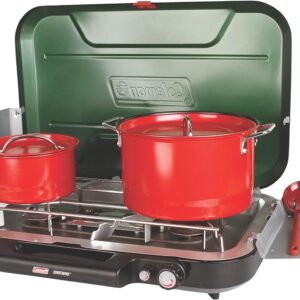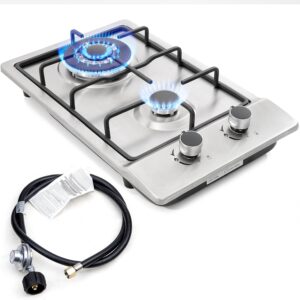Outdoor Camping Stoves
Showing all 4 results
-
Sale!

Coleman Classic Portable 3-Burner Propane Camping Stove, Instant Ignition, Wind Guards, Pressure Control, Carry Handle – 28,000 BTUs
Original price was: $179.99.$158.00Current price is: $158.00. -

Koblenz Victoria 4-Burner Gas Stove, Bronze, 16,000 BTUs, 18″ x 24
$64.90 -

Forimo Portable Propane Gas Cooktop, Single Burner Stove with Auto Ignition, Tempered Glass, Ideal for Camping, RVs, Apartments, and Outdoor Cooking
$55.99 -

Forimo 12-Inch Stainless Steel Gas Cooktop with 2 Burners, Drop-in Propane/Natural Gas Cooker, Dual Fuel 12″ Gas Stove Top for Easy Cleaning (12″W x 20″L)
$99.99
Outdoor Camping Stoves: Portable Cooking Solutions for Wilderness Adventurers
Outdoor camping stoves are essential tools for wilderness adventurers who seek to enjoy delicious and hot meals during their outdoor excursions. These portable cooking appliances provide a convenient and efficient way to prepare food in remote locations, such as campsites, hiking trails, and backpacking trips. In this article, we will explore the features, types, and benefits of outdoor camping stoves and how they enhance the camping experience.
Features of Camping Stoves:
Portability: Camping stoves are designed to be lightweight and compact, allowing easy transportation in backpacks or camping gear.
Fuel Types: They are available in various fuel options, including canister fuel, liquid fuel, and wood. Canister fuel stoves are popular for their simplicity and ease of use, while liquid fuel stoves offer better performance in extreme conditions. Wood-burning stoves provide a renewable and eco-friendly option for fuel.
Stability: Camping stoves are designed with sturdy legs or support structures to ensure stability on uneven terrain.
Adjustable Flame: Most camping stoves come with adjustable knobs or levers to control the flame, allowing for precise temperature regulation.
Quick Ignition: Many camping stoves feature piezoelectric igniters or matchless lighting systems for easy and safe ignition.
Types of Camping Stoves:
Canister Stoves: Canister stoves are compact and easy to use, using pre-pressurized fuel canisters that screw onto the stove. They are lightweight and ideal for short camping trips.
Liquid Fuel Stoves: Liquid fuel stoves use white gas, kerosene, or unleaded gasoline as fuel. They perform well in extreme conditions and at high altitudes, making them suitable for longer expeditions.
Wood-Burning Stoves: Wood-burning camping stoves use sticks, twigs, and other natural materials as fuel, making them an eco-friendly and sustainable option. They are popular among minimalist campers and hikers who want to travel light and reduce their environmental impact.
Solid Fuel Stoves: Solid fuel stoves use compact fuel tablets or cubes that burn to generate heat. They are lightweight and suitable for emergencies or as backup stoves.
Benefits of Outdoor Camping Stoves:
Hot Meals on the Go: Camping stoves allow campers to enjoy hot and cooked meals, making the camping experience more comfortable and enjoyable.
Portability: Their lightweight and compact design makes camping stoves easy to carry and perfect for backpackers and hikers.
Time-Saving: Cooking with a camping stove is faster than traditional campfire cooking, saving valuable time during outdoor adventures.
Safety: Camping stoves provide a controlled and contained cooking environment, reducing the risk of accidental fires.
Versatility: With various types of camping stoves available, campers can choose the one that best suits their needs and cooking preferences.
Safety Considerations:
Stable Placement: Ensure that the camping stove is placed on a flat and stable surface to prevent tipping.
Ventilation: Use camping stoves in well-ventilated areas to avoid carbon monoxide buildup.
Fire Safety: Have a fire extinguisher or access to water nearby in case of emergencies.
Cooling Period: Allow the stove to cool completely before packing it away.
Conclusion:
Outdoor camping stoves are invaluable companions for adventurers seeking to explore the wilderness while enjoying delicious and hot meals. With their portability, efficiency, and various fuel options, camping stoves provide a convenient way to cook in the great outdoors.
Whether it’s a weekend camping trip or an extended hiking expedition, these stoves allow campers to savor the culinary delights of home-cooked food, making the camping experience even more enjoyable and memorable. However, campers should always prioritize safety and proper stove usage to ensure a safe and delightful camping journey.






